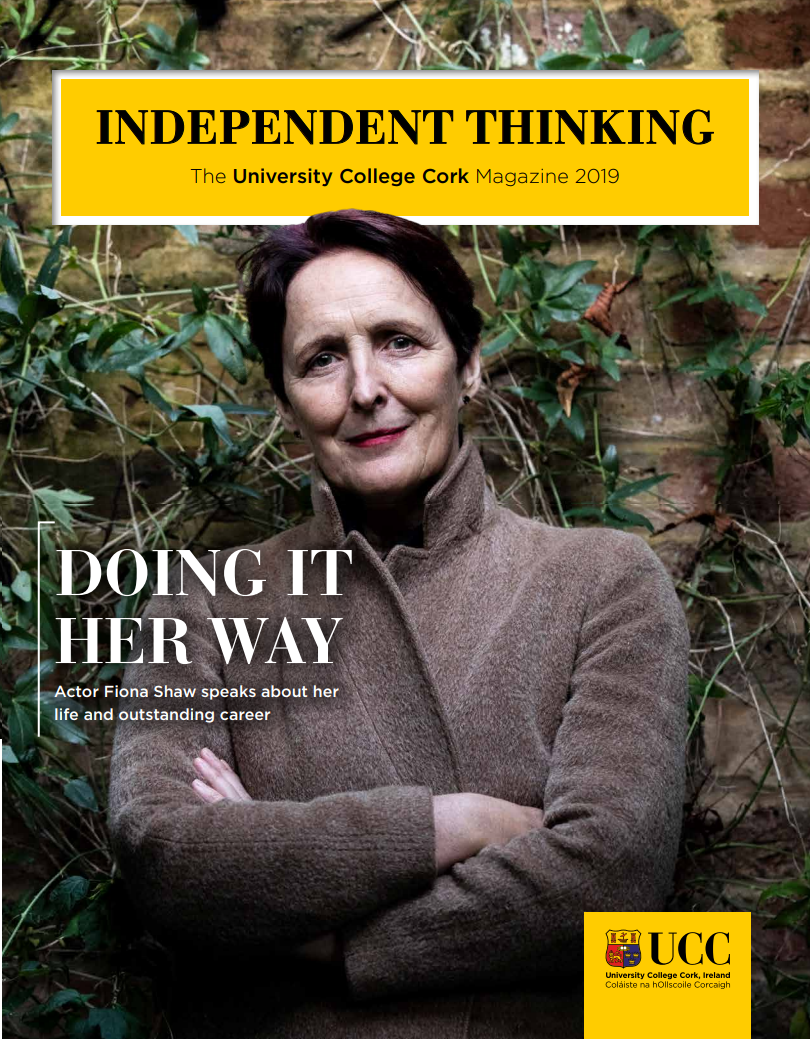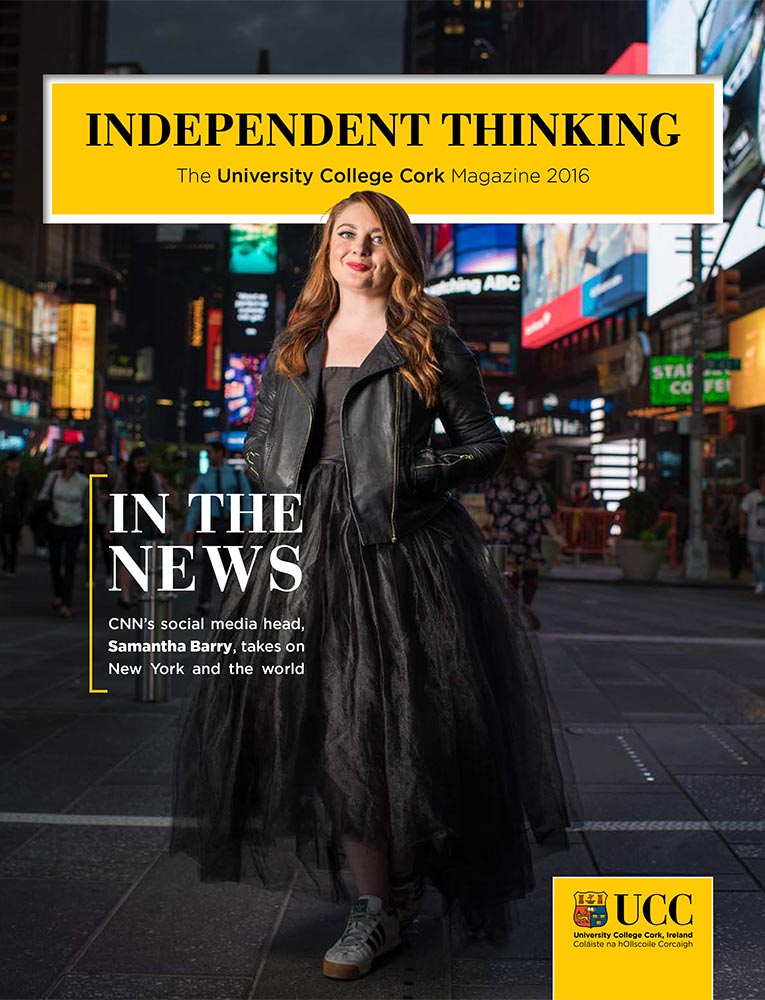Features
- President's Welcome
- Raising Hope
- Back to UCC for Cork’s Crime Writing Queen
- Committed to Memory
- An Ghaeilge i Lár an Aonaigh san Aontas Eorpach
- UCC Love Stories: Summer 2023
- Spotlight On Sport
- Crassvirus Breakthrough Is A ‘Crowning Moment’
- Envisioning Future Sustainable Cities
- The ‘Living Classroom’: Engaging With the ‘Great Existential Challenges of Our Time’
- Summer Celebrations
Crassvirus Breakthrough Is A ‘Crowning Moment’
The first-ever mapping of the crassvirus, the most abundant group of viruses in the human gut, has been hailed as a ‘breakthrough’ moment. Here, Professor Colin Hill, co-lead of the study, discusses how this discovery could shape human health and serve as a building block for the scientific breakthroughs of tomorrow. In conversation with Marjorie Brennan.

Professor Colin Hill is telling me about the result of his latest breakthrough. "I really want to share a picture of what it looks like. It's absolutely gorgeous. I don’t know if you've seen it; it’s beautiful," he says. I assure him I have seen it and indeed, it is rather pleasing to the eye, resembling, to this layperson at least, a giant lollipop-shaped bouquet of tiny flowers.
This glorious creation is in fact the first ever structural atlas of a crassvirus, the most abundant group of viruses in the human gut, which can play an important role in shaping the gut microbiome and in turn lead to better treatment of disease. Colin, co-lead study researcher and founding Principal Investigator in APC Microbiome Ireland, based in UCC, is one of a team who collaborated with scientists in the University of York to produce the atomic-level structure of the novel virus, which attacks and kills bacteria in the human gut.
"We can see that in some people, 90 percent or more of all the viruses in their gut are just a single crassvirus. But nobody had ever managed to grow it in a lab, so we knew very little about it," says Colin. "We knew it was incredibly abundant and everybody has it, but we didn’t know what bacteria it was killing. About five years ago, we were the first lab in the world to grow one of these viruses. We use the expression 'you have to grow it to know it'. You can’t really know much about something just from its genetic blueprint."
He goes on to describe the monumental effort that then went into mapping the crassvirus:
"This was an extraordinary technique used by our collaborators in York. They take millions of pictures of individual viruses and superimpose them, one on top of another [using a cryo-electron microscope] until they get the most incredibly detailed picture that’s imaginable, where you can zoom in and see almost individual atoms. So that picture isn’t an artist's impression of what it might look like or a drawing of what we think it looks like – that’s it. It is an extraordinary thing to do in terms of an entire virus. And of course, in the background, we’re understanding how it grows and what it does to cells. It is really important to understand all of this because, without understanding these viruses, we will never really understand the microbiome properly."
The study was published in the prestigious journal Nature in May, a crowning moment for any scientist. Colin says there were years of work leading up to the publication and, like many scientific endeavours, collaboration was the key:
"For a lot of scientists, getting a paper into Nature or Science is the holy grail, like getting an Oscar. That was the achievement – finally understanding exactly what the virus looks like. A lot of that was down to Andrey Shkoporov, a superb scientist. He grew it in the lab first, and he was the one who told me about the work they were doing in York and suggested we collaborate with them. It was five years without a single publication. We had to invest long-term, we had to be patient. We could have tried to publish as we went along, saying we’ve solved this little bit and we’ve solved that bit. But we all decided, let’s just try and do the whole thing in one go. Oli Bayfield and Fred Antson were the two scientists in York, and they were amazing."

In terms of real-life application of the discovery, Hill says he hopes the shared knowledge will prove to be a building block of future breakthroughs in the field:
"We think in the future, in terms of microbiome-based interventions and therapies, we will have to manipulate the microbiome and fix it – for want of a better word – if it’s gone wrong. We’ll only be able to do that if we understand the role of these viruses. We are not going to be giving these viruses to people tomorrow to cure a disease or anything – it is not that immediate. We are confident that the scientific world will find ways to apply this, even if we can’t."
Meanwhile, another scientific discovery in which Colin was involved is inching further towards making a real difference in healthcare. Adiso Therapeutics, a company set up by Colin and his colleague Professor Paul Ross, Director of APC, was recently awarded Spin-Out Company of the Year at the UCC Research Awards. The company is working on using bacteria to treat infection in the gut, which it hopes can be used to tackle the spread of clostridioides difficile infections in hospitals.
"You get into a recurring cycle of infection and, unfortunately, a significant number of people die as a result of this. We isolated bacteria from the gut that can kill this bacterium. So, what we want to do is develop this as a therapeutic. We want to grow up this bacteria, put it in a tablet, and deliver it to people into the gut where it will kill clostridioides difficile and break that cycle," says Colin.
The company has attracted significant venture capital investment and completed phase one trials, which test safety.
"We are now getting ready for a phase two, which would see does it actually treat or cure the disease. We have done what many people think is the hard bit. We have developed it, had it made to pharmaceutical standards, and we have it in tablets – it is not easy to get bacteria to survive in a tablet. We can deliver it to people, and it is safe. The next bit is very expensive, but it could be relatively short – as in three to five years, to prove that it really works and have it adopted and go out into practice," says Colin.
Colin has been involved in many scientific breakthroughs in a long and illustrious career. He says the passion and determination of the many people he has mentored and worked with over the years drives him forward:
"To see people come in to the lab with a basic degree, and then, three or four years later, they’re throwing ideas at you and doing this amazing work, it is just fantastic. They are enthusiastic, engaged, hard-working; and you just facilitate them, get out of their way more than anything else. So many graduates from the lab are now professors or at a high level in industry and research."
Then there is always the thrill of that elusive eureka moment:
"There are days when you are the first person in the universe to know something about the universe. That is pretty special. You combine those two things, discovery and brilliant people … that is what keeps me going."
For the latest research news and stories, visit the dedicated UCC Research and Innovation website.
Photography: Clare Keogh



